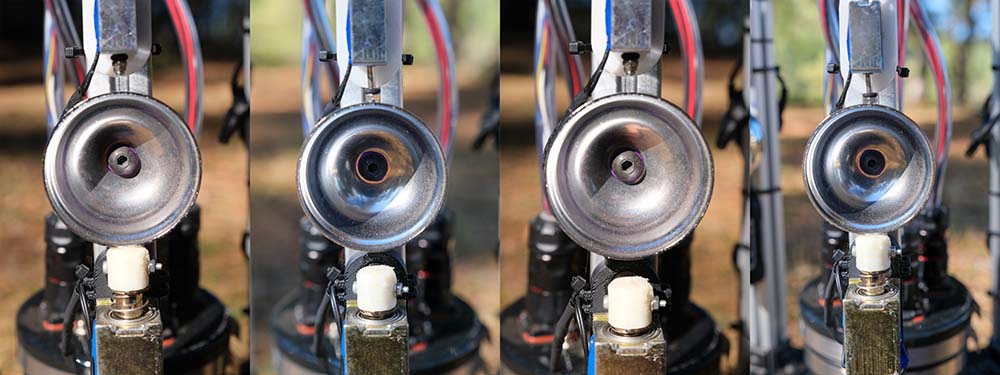Explorator Chirper
Explorator Chirper is the first species created using the Explorator framework. It is the size of a small dog and
consists of three different sized desk-bells struck by solenoid plungers and dampened with a solenoid dampening
mechanism. The artistic goal of the Explorator Chirper species (common name Chirper) is to bring attention to the
rhythmic and tonal variations of animal vocalizations through a process of rough imitation. Chirper serves as a
speculative sound object that speculates on a future where intelligent mechatronic creatures sonically explore
habitats and attempts to develop a dialogue with natural environments through the ringing of its bells. In this
vein, it is not the goal of Chirper to accurately mimic the sounds it hears, but instead to deconstruct them into
their fundamental elements of relative pitch, length, and amplitude and then use that abstracted data to produce its
vocalizations.
To participate in a dialogue with the soundscape, Chirper is placed in a natural environment and listens for the
onset of sonic events. Once Chirper identifies an onset, it continues to listen to see if it can identify a rhythm.
If a rhythm is identified through the occurrence of multiple onsets within a short period, Chirper responds first by
memorizing the new rhythm's temporal and tonal relationships and second by vocalizing one of its already learned
rhythms as a "response" in an attempt to create a dialogue with the sonic environment. If Chirper experiences a
period of prolonged silence, it attempts to initiate the call-and-response dynamic by vocalizing one of its
memorized rhythms as an initial "call." Using data collected from its eye-stock, Chirper is more likely to actuate
its bells when conditions are warm, dry, and bright and less likely to vocalize when the weather is cold, wet,
humid, or dark.
Dampened Bell Actuators

To produce sustained notes, Chirper needs an actuator configuration that possesses control over individual notes'
dynamic envelope. To distinguish between vocalization pitches Chirper needs control over the frequency content of
its vocalizations. While many configurations could have served these needs, the Chirper opts for three desk-bells of
differing sizes, which each contain a dampening mechanism and a striking mechanism. The ability to strike while
dampened and when undampened, along with the ability to control the dampening time gives each mechanism considerable
control over the bells' envelope.
The dampening solenoid utilizes a 3D printed weather-resistant rubber-like (TPA or FLEX PLA) cover attached to the
top of a push-pull solenoid plunger. The solenoid is mounted close to the bell so that the plunger's rubber end
comes into contact with the bell when the solenoid is deactivated and is removed from the bell when the solenoid is
activated. A smaller solenoid is mounted on the opposite side of the bell. It is positioned so when activated, the
bell is struck, and when deactivated, the plunger rests several millimeters away from the bell. Both solenoids are
mounted to an extruded aluminum beam using PETG 3D printed mounts and TPA mount dampeners.
Body and Enclosure
Chirper utilizes a 16 mm thick MDF body, painted black and treated with polyurethane to protect the wood from
moisture. The body mechanically suspends the electronics enclosure a variable distance from the ground with three
independently adjustable M12 bolts attached to the body with t-nuts. The electronics enclosure is a black 100 mm
wide PVC pipe, which contains two internal compartments that keep the PCB and battery separated. The battery is
accessed by unscrewing a threaded pipe-cap while the top of the enclosure consists of a 3D printed plastic cap,
weather-proofed using paint and polyurethane.
The enclosure protected units from environmental conditions on several occasions including a stint fully exposed in
a winter rain-storm for several days in a row. However, the M12 bolt and t-nut leg configuration proved unsteady due
to the t-nuts and time consuming to adjust due to the M12 threading. Furthermore, while the enclosure proved robust,
it proved somewhat over-designed in terms of environmental protection and stability resulting in a hefty and
relatively large unit weighing 5622 grams.
Laser-cut clear acrylic is stacked with rubber o-rings preventing unwanted ingress occurring between the layers.
IP-67 rugged connectors are attached to the enclosure's bottom acrylic plate and are used to connect the eye-stock
to the main enclosure electronically. The top of the enclosure contains cut-outs over the microphone to provide
better acoustics. A thin film of plastic sandwiched between the top two acrylic layers protects the enclosure's
inside from liquid and particulate ingress. This enclosure is utilized in the Chirper as well as the Chipper species
introduced in the next section.